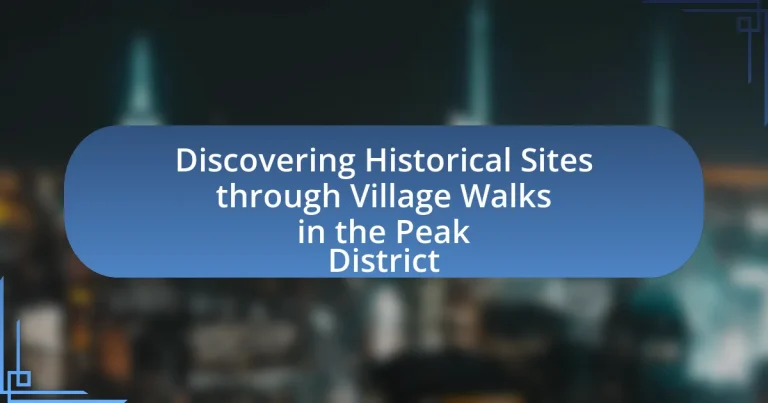The article focuses on discovering historical sites through village walks in the Peak District, highlighting significant locations such as Chatsworth House, Eyam, and Peveril Castle. It emphasizes the cultural and historical importance of these sites, detailing their connections to local heritage, notable events, and figures like Sir Richard Arkwright. The article also discusses the benefits of village walks, including enhanced cultural understanding and physical well-being, while providing practical tips for planning walks, navigating terrain, and respecting local communities. Additionally, it outlines available resources, maps, and local organizations that support exploration of the region’s rich history.

What are Historical Sites in the Peak District?
Historical sites in the Peak District include Chatsworth House, a stately home dating back to the 16th century, and Eyam, known as the “Plague Village” for its historical significance during the bubonic plague in 1665. Additionally, the ruins of Peveril Castle, built in the 11th century, and the historic market town of Bakewell, famous for its pudding, are notable sites. These locations reflect the rich cultural heritage and history of the Peak District, attracting visitors interested in both architecture and historical events.
Why are these sites significant to local history?
These sites are significant to local history because they embody the cultural, architectural, and social evolution of the Peak District region. Historical sites such as ancient churches, mills, and village squares reflect the community’s heritage and the economic activities that shaped its development. For instance, the presence of a 17th-century mill demonstrates the area’s industrial past and its reliance on water power, while local churches often serve as landmarks of community identity and historical continuity. These elements collectively provide insights into the lives of past inhabitants, their traditions, and the historical events that influenced the region’s growth and character.
What events or figures are associated with these historical sites?
The historical sites in the Peak District are associated with significant events and figures such as the Industrial Revolution, which transformed the region’s economy and landscape, and notable individuals like Sir Richard Arkwright, a pioneer of the factory system. The area is also linked to the Peak District National Park’s establishment in 1951, which was influenced by conservationists like John Ruskin. These events and figures highlight the cultural and industrial heritage of the Peak District, showcasing its importance in British history.
How do these sites reflect the culture of the Peak District?
The historical sites in the Peak District reflect the culture of the region by showcasing its rich heritage, traditional architecture, and historical significance. For instance, the presence of stone-built villages and ancient churches illustrates the area’s long-standing agricultural practices and community values. Additionally, sites like Chatsworth House and Eyam Village highlight the local history of land ownership and the impact of the plague, respectively, emphasizing the resilience and adaptability of the communities. These elements collectively demonstrate the Peak District’s cultural identity, rooted in its history, architecture, and social evolution.
What types of historical sites can be found in the Peak District?
The Peak District features a variety of historical sites, including ancient stone circles, Roman ruins, and medieval churches. Notable examples include the neolithic stone circle at Arbor Low, which dates back to around 2500 BC, and the remnants of the Roman fort at Brough-on-Noe, established in the 1st century AD. Additionally, the region is home to numerous historic villages, such as Eyam, known for its role during the bubonic plague in the 17th century, and the medieval church of St. Lawrence in Bakewell, which showcases architectural styles from the 12th century onwards. These sites collectively reflect the rich cultural and historical heritage of the Peak District.
What are the most notable ancient structures in the area?
The most notable ancient structures in the Peak District area include the stone circles of Arbor Low and the neolithic burial mounds at the site of the Nine Ladies. Arbor Low, dating back to around 2500 BC, is a significant henge monument that showcases the area’s prehistoric significance. The Nine Ladies, a stone circle believed to be constructed around the same time, serves as a testament to the region’s ancient rituals and burial practices. These structures are recognized for their historical and archaeological importance, attracting visitors interested in the rich heritage of the Peak District.
How do industrial heritage sites contribute to the region’s history?
Industrial heritage sites significantly contribute to the region’s history by preserving the legacy of past industrial activities and showcasing the technological advancements of their time. These sites, such as former mills, quarries, and factories, serve as tangible reminders of the economic and social transformations that shaped the Peak District. For instance, the cotton mills in the region highlight the impact of the Industrial Revolution on local communities, illustrating how industrialization influenced labor patterns, migration, and urban development. By maintaining these structures, the region not only honors its historical narrative but also provides educational opportunities for visitors to understand the historical context and significance of industrial practices in shaping contemporary society.

How can Village Walks Enhance the Experience of Discovering Historical Sites?
Village walks enhance the experience of discovering historical sites by providing immersive, contextual insights into the local culture and history. Engaging with the landscape and community during these walks allows visitors to connect with the historical significance of sites in a more meaningful way. For instance, walking through the Peak District’s villages, such as Eyam, offers firsthand experiences of historical events like the plague outbreak in the 17th century, which can be better understood through local narratives and guided tours. This direct interaction with the environment and local stories enriches the educational aspect of historical exploration, making it more memorable and impactful.
What are the benefits of exploring historical sites through village walks?
Exploring historical sites through village walks offers numerous benefits, including enhanced cultural understanding and physical well-being. Engaging with local history allows individuals to connect with the heritage and traditions of the area, fostering a deeper appreciation for the community’s past. Additionally, walking promotes physical health by encouraging exercise, which can improve cardiovascular fitness and overall well-being. Studies indicate that walking in natural environments, such as those found in the Peak District, can also reduce stress and enhance mental health. Therefore, village walks not only provide an opportunity to learn about history but also contribute positively to physical and mental health.
How do village walks provide context to the historical sites?
Village walks provide context to historical sites by allowing visitors to experience the surrounding environment and local culture that shaped these sites. Engaging with the village’s architecture, landscape, and community stories enhances understanding of the historical significance of landmarks. For instance, walking through a village may reveal traditional building styles that reflect the region’s history, such as stone cottages that date back centuries, illustrating the area’s architectural evolution. Additionally, local narratives shared by residents can offer insights into historical events, such as the impact of the Industrial Revolution on village life, thereby deepening the visitor’s appreciation of the historical sites within that context.
What unique perspectives do local guides offer during these walks?
Local guides offer unique perspectives during village walks in the Peak District by providing in-depth knowledge of the area’s history, culture, and geography. Their insights often include personal anecdotes and local legends that enrich the experience, making historical sites more relatable and engaging. For instance, guides may share specific stories about the significance of a particular building or landmark, such as its role in local events or its architectural features, which are not typically found in guidebooks. This localized knowledge enhances visitors’ understanding and appreciation of the historical context, allowing for a more immersive exploration of the Peak District’s heritage.
What should walkers consider when planning their village walks?
Walkers should consider the historical significance of the sites they plan to visit during their village walks. Understanding the historical context enhances the experience, as the Peak District is rich in heritage, featuring landmarks such as ancient stone circles and historic mills. Additionally, walkers should evaluate the terrain and trail conditions to ensure safety and accessibility, as some paths may be uneven or steep. Weather conditions are also crucial; checking forecasts can help walkers prepare adequately for their journey. Lastly, walkers should plan their route to include key historical sites, ensuring they maximize their exploration of the area’s cultural heritage.
What are the best routes for discovering historical sites?
The best routes for discovering historical sites in the Peak District include the Monsal Trail, which follows a former railway line and passes through several historic villages and landmarks, and the Derwent Valley Heritage Way, which showcases the area’s industrial heritage. These routes are well-marked and provide access to sites such as the Chatsworth House and the historic mills along the Derwent River. The Monsal Trail spans approximately 8.5 miles and features tunnels and viaducts, while the Derwent Valley Heritage Way covers around 55 miles, highlighting the region’s rich history in lead mining and textile production.
How can walkers prepare for varying terrain and weather conditions?
Walkers can prepare for varying terrain and weather conditions by selecting appropriate footwear, carrying essential gear, and checking weather forecasts. Proper footwear, such as hiking boots with good traction, helps navigate uneven surfaces and provides ankle support. Essential gear includes waterproof jackets, hats, and gloves for protection against rain and cold, while hydration packs and snacks ensure energy levels are maintained. Checking weather forecasts allows walkers to anticipate changes in conditions, enabling them to adjust their plans accordingly. These preparations are crucial for safety and comfort during walks in diverse environments like the Peak District.

What Resources are Available for Discovering Historical Sites through Village Walks?
Resources available for discovering historical sites through village walks in the Peak District include local guidebooks, online heritage trails, and community-led walking tours. Local guidebooks often provide detailed maps and descriptions of historical landmarks, while online heritage trails, such as those offered by the Peak District National Park Authority, allow users to explore sites digitally before visiting. Community-led walking tours, organized by local history groups, offer expert insights and narratives about the area’s history, enhancing the experience for participants. These resources collectively facilitate a deeper understanding of the historical significance of various sites within the Peak District.
What maps or guides are recommended for exploring the Peak District?
The recommended maps and guides for exploring the Peak District include the Ordnance Survey (OS) Explorer maps, specifically the OS Explorer 1:25,000 scale maps, which provide detailed topographical information essential for navigating the area. Additionally, the “Peak District National Park Official Visitor Guide” offers insights into historical sites and village walks, making it a valuable resource for visitors. These maps and guides are widely recognized for their accuracy and comprehensiveness, ensuring that explorers can effectively plan their routes and discover the rich history of the Peak District.
How can technology enhance the experience of village walks?
Technology can enhance the experience of village walks by providing interactive maps and augmented reality applications that offer historical context and information about landmarks. For instance, GPS-enabled apps can guide walkers through the Peak District, highlighting significant historical sites and providing detailed descriptions, images, and audio narratives. Research indicates that the use of mobile technology in tourism can increase visitor engagement by up to 30%, as it allows for a more immersive experience. Additionally, wearable devices can track walking routes and fitness metrics, encouraging exploration and promoting health benefits.
What local organizations provide information on historical sites?
Local organizations that provide information on historical sites in the Peak District include the Peak District National Park Authority and local heritage societies such as the Derbyshire Archaeological Society. The Peak District National Park Authority offers resources and guides on historical landmarks within the park, while the Derbyshire Archaeological Society conducts research and shares findings related to the region’s history. These organizations play a crucial role in preserving and promoting the historical significance of the area, ensuring that visitors and residents have access to accurate and detailed information about the historical sites.
What are some tips for a successful village walk in the Peak District?
To ensure a successful village walk in the Peak District, plan your route in advance, focusing on historical sites of interest. Research the villages, such as Eyam and Castleton, which are rich in history and offer guided walks that highlight their significance. Dress appropriately for the weather and wear sturdy footwear, as the terrain can be uneven. Carry a map or use a navigation app to stay on track, as some paths may not be well-marked. Additionally, consider visiting during off-peak times to avoid crowds and enhance your experience of the historical context.
How can walkers ensure they respect the local environment and communities?
Walkers can ensure they respect the local environment and communities by adhering to established guidelines such as the Leave No Trace principles. These principles advocate for minimizing impact on natural areas, which includes staying on marked paths to prevent soil erosion and protecting native vegetation. Additionally, walkers should engage with local communities by respecting private property, seeking permission when necessary, and supporting local businesses, which fosters positive relationships and economic benefits for residents. Research indicates that responsible tourism practices can enhance community well-being and environmental conservation, as seen in various studies on sustainable tourism in rural areas.
What should walkers do if they encounter challenges during their walk?
Walkers should assess the challenge they encounter during their walk and take appropriate action based on the situation. If faced with difficult terrain, walkers should carefully navigate or find an alternative route to ensure safety. In case of inclement weather, it is advisable to seek shelter or postpone the walk. If lost, walkers should retrace their steps or use a map and compass to regain their bearings. Additionally, if they encounter wildlife or other hazards, maintaining a safe distance is crucial. These actions are supported by guidelines from outdoor safety organizations, which emphasize preparedness and adaptability in outdoor activities.


